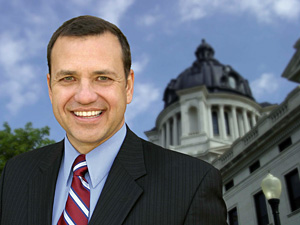One of the great laments within the chiropractic profession, and within all non-allopathic health care professions, for that matter, has been that they are effectively on the "outside" when it comes to policy discussions, insurance inclusion, legislative progress and more.
Q: Why did you decide to become a chiropractor, and how did your chiropractic background influence/shape your interest in public service on a political level?
A: My first experience with chiropractic care was when I was wrestling in high school. I injured myself during a tournament and couldn't walk the next day. My mom set up an appointment with our family chiropractor. After two visits I was wrestling again. That made quite an impression on a 15-year-old kid. I always saw myself doing that [chiropractic] someday, and it stayed with me.
 My interest in serving and caring for people took on a different dimension in 2001. I had just finished serving as president of the South Dakota Chiropractors Association and had lobbied hard with success the passage of our sports physical bill, allowing chiropractic physicians to perform athletic physicals. I became interested in what was going on in my community and before I knew it, I ran for city council and was the top vote-getter during that election. After serving two years of a four-year term, I ran for mayor and served two terms as mayor of the city of Brookings, a community with a population of about 20,000.
My interest in serving and caring for people took on a different dimension in 2001. I had just finished serving as president of the South Dakota Chiropractors Association and had lobbied hard with success the passage of our sports physical bill, allowing chiropractic physicians to perform athletic physicals. I became interested in what was going on in my community and before I knew it, I ran for city council and was the top vote-getter during that election. After serving two years of a four-year term, I ran for mayor and served two terms as mayor of the city of Brookings, a community with a population of about 20,000.
As chiropractic physicians, our keen interest in people and their well-being is a natural fit for public service in the community. We lean toward looking at problems from a holistic point of view and are focused on solving problems - every minute of every day. Our small-business experience cannot be discounted, either. All of these skills translate into an effective background for public service. I believe my election as governor will inspire other chiropractors to run for elective office.
Q: What are the main points of your platform, particularly as they relate to health care and health care reform?
A: I spent two years researching and writing a plan for South Dakota, available on my campaign Web site (www.munstermanforgovernor.com). I developed 10 key policy areas to solve current problems and move our state forward. I dedicated a chapter to health care that I encourage my colleagues to read. In health care, we need to provide accessibility of health care, but also cost-containment measures. Without both, we will have a system that will not produce the results we need. Our cost-containment primarily needs to be focused on preventing and managing disease processes, keeping competition alive, and well and tort reform.
As mayor, I initiated a city wellness pilot project through the Department of Health. This lead to a heightened focus of how we plan our park and recreation programming and infrastructure in our community. During my time as mayor, I led a partnership between South Dakota State University and Brookings on an exciting new venture to complement improved lifestyle infrastructure and programs in the community by adding a unique twist to SDSU's health promotion curriculum.
 Since fall 2008, the health promotion curriculum has put to good use the skills and talent of these students in a wellness coaching format for the citizens of Brookings. This pilot program may lead to a larger program, implemented in more communities across South Dakota. The Robert Wood Johnson Foundation and the University of Wisconsin Population Health Institute recently presented findings for counties in 50 states as part of the 2010 County Health Rankings. Brookings County was ranked number one - the healthiest county in South Dakota - and ranked high among other counties in the nation.
Since fall 2008, the health promotion curriculum has put to good use the skills and talent of these students in a wellness coaching format for the citizens of Brookings. This pilot program may lead to a larger program, implemented in more communities across South Dakota. The Robert Wood Johnson Foundation and the University of Wisconsin Population Health Institute recently presented findings for counties in 50 states as part of the 2010 County Health Rankings. Brookings County was ranked number one - the healthiest county in South Dakota - and ranked high among other counties in the nation.
As a mayor, I also learned early on how important the smaller communities were to our city's growth and success, so I led the effort for a regional partnership to strengthen our economy and provide opportunities for our young families to stay. As a result, the Brookings region was recently ranked third in the nation among the least economically stressed counties in America. I want to bring this same type of strategic leadership to the state level and implement a plan to grow our whole state. In our rural state, only one-third of our communities are growing and two-thirds are declining. I believe we can reverse that trend with a sound strategic development plan that is based upon the premise that we are only as strong as our smallest community.
Q: From a chiropractic perspective, what is your opinion of the health care reform legislation as it impacts the profession and patients?
A: My major concern has to do with the control of health care decisions in the long run. My concern is that this legislation, as well-intentioned as it is, could lead us down the road to a single-payer system. A single- payer system will lower quality and health care choices. I have always fought for patient rights alongside many of my colleagues over the years. We must keep a keen eye toward any inclination to force insurance companies out of business, and we must stand against a full government takeover of health care.
Q: How can the chiropractic profession best position itself to influence and participate in health-care policy decisions on a state and national level?
A: We all must do our part to elect key people to those positions. That means taking an active role in supporting campaigns on the local, state and national level. We also need more of our doctors running for elected leadership positions. We (as doctors) have a wealth of knowledge to share and contribute to mankind in this arena.
Having a chiropractic physician elected as one of only 50 governors in our country will assure our professional point of view will be represented front and center during the ongoing development of our health care system in the nation. States are taking an active response and will play a strategic role, as outlined in the new law, through the use of exchanges and the development of health care policy.
Q: In your opinion, what are the main factors (internal and external) keeping the chiropractic profession from advancing in mainstream health care, and what can it do to better its position?
A: I truly believe we have to be ready to collaborate with other health care providers without compromising our values. We each provide a valuable component to the health care team. I recently left my practice (last August) to campaign full time. I started my practice 25 years ago as a solo practitioner, not knowing anyone in the community. The practice I left had six chiropractic physicians, two pain-management MD anesthesiologists, a physical therapist, two podiatrists, a neurosurgeon, a behavioral psychologist and three massage therapists. This innovative practice was a dream when I first started.
In addition, I believe we, as chiropractic physicians, must preserve and practice our skills as providers of primary health care services. With the loss of family-practice and internal-medicine allopathic physicians, it is nurse practitioners, physician assistants and chiropractic physicians who will fill the gap for frontline health care in our nation. And our background will position us as the health care providers who are the "wellness experts."
Q: If you could change only one thing to help achieve the above, what would it be?
A: We need to improve our profession by continuing to be patient-centered in our approach and document our successes to the world. And we need to employ our holistic approach to wellness. Our time has arrived - society and health care are ready for the doctor of chiropractic's training, knowledge and skills. We just need to crystallize our vision and shine in our work. I think our profession needs a vision that all chiropractic physicians can support and get excited about.
About 13 years ago, I started a chiropractic PPO in South Dakota to fight to provide local control of health care decision-making for our doctors and our patients. Our success has grown in six surrounding states. As a part of this network, we have developed a best-practice program. This program is geared to not only standardize our diagnosis of conditions, but also collaborate with each other to share our clinical experiences and develop a best practice to treating conditions. As a result, we are now accumulating outcome data that will be reliable and will eventually become published.
The primary election in South Dakota is June 8. To support Dr. Scott Munsterman's campaign for governor, make a contribution online at www.munstermanforgovernor.com or send a check to:
Munsterman for Governor
306 4th Street Suite F
Brookings, SD 57006
Dynamic Chiropractic editorial staff members research, investigate and write articles for the publication on an ongoing basis. To contact the Editorial Department or submit an article of your own for consideration, email
.




